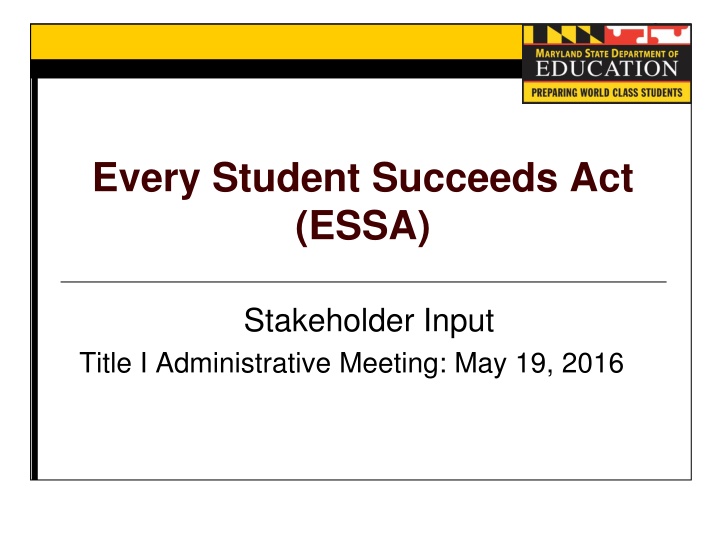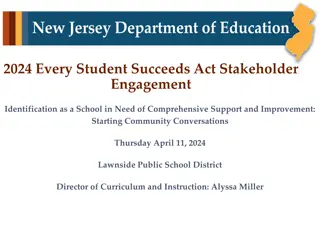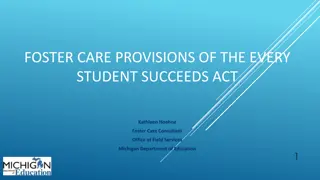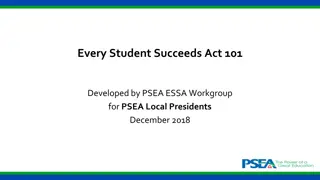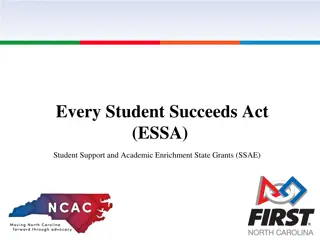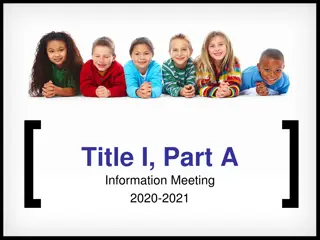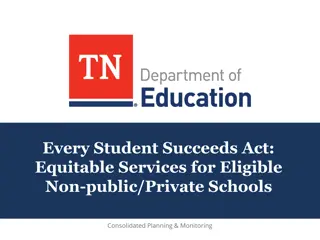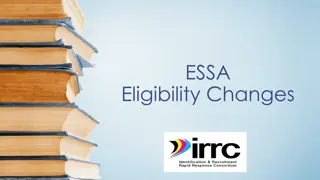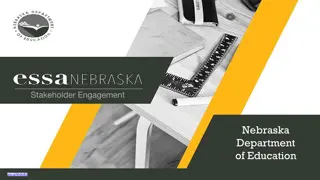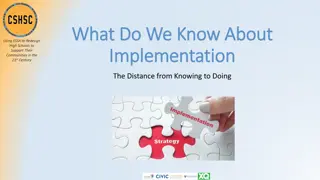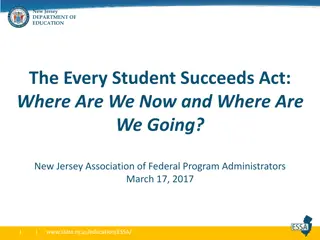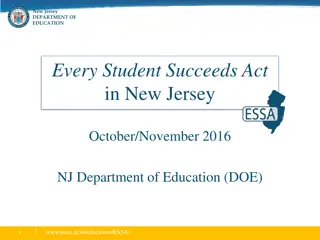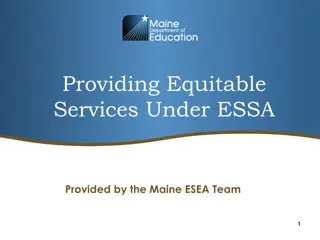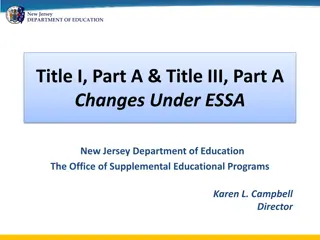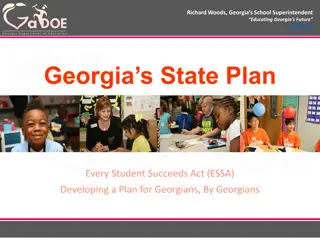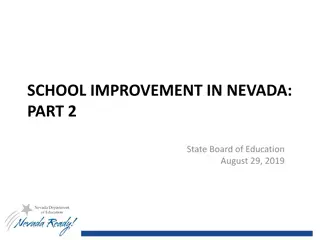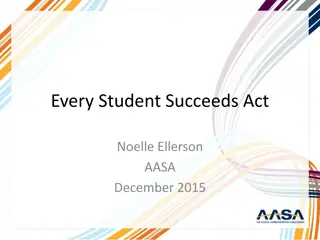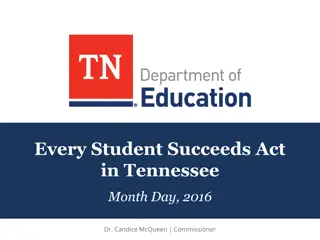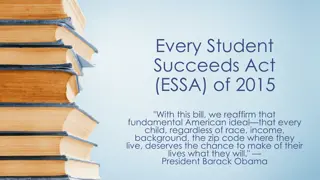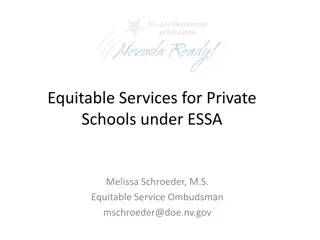Overview of Changes in the Every Student Succeeds Act (ESSA)
The Every Student Succeeds Act (ESSA) signifies a significant improvement over the No Child Left Behind Act (NCLB) by returning control to states and localities. ESSA maintains a federal role to support and strengthen education without dictating requirements, emphasizing a balance between federal oversight and local autonomy. The transition from NCLB to ESSA involves changes in standards, assessments, and funding distribution, with states now having more flexibility in implementing academic standards and assessments. ESSA's timeline indicates the shift in federal funding and authority, aiming to enhance educational outcomes through a collaborative approach between federal, state, and local entities.
Download Presentation

Please find below an Image/Link to download the presentation.
The content on the website is provided AS IS for your information and personal use only. It may not be sold, licensed, or shared on other websites without obtaining consent from the author.If you encounter any issues during the download, it is possible that the publisher has removed the file from their server.
You are allowed to download the files provided on this website for personal or commercial use, subject to the condition that they are used lawfully. All files are the property of their respective owners.
The content on the website is provided AS IS for your information and personal use only. It may not be sold, licensed, or shared on other websites without obtaining consent from the author.
E N D
Presentation Transcript
Every Student Succeeds Act (ESSA) Stakeholder Input Title I Administrative Meeting: May 19, 2016
Objectives Compare the Elementary Secondary Education Act (ESEA)/No Child Left Behind (NCLB) and ESSA Identify the most substantive changes Preview what Maryland is doing to prepare for the transition and the new law Gather input for Maryland s plan to implement the new law
Timeline and Implementation for ESSA Elementary and Secondary Education Act (ESEA) 1965 No Child Left Behind (NCLB) 2001 ESSA was signed into law on December 10, 2015 Current ESEA waivers expire August 1, 2016 School year 2016-2017 is a transition year New ESSA provisions go into effect for the 2017-2018 school year Federal Fiscal Year (FFY) 2016 competitive and formula funding will flow through ESEA construct for school year 2016-2017; FFY 2017 dollars will flow through ESSA construct (in schools for 2017- 2018 school year)
What is in ESSA? Significant improvement over current law Maintains federal role, but emphasizes that this role is to support/strengthen, not to dictate/prescribe Returns pendulum of federal overreach and prescription back to states and locals
Substantive Changes Federal v. State and Local Control in ESSA State and Local Federal
Standards NCLB/ESEA Flex ESSA Academic content standards in ELA, Math, and Science Flex required States to adopt college and career-ready standards that are common to a significant number of States or the State had to adopt college and career-ready standards that have been approved and certified by a State network of institutions of higher education (IHE). Challenging State Academic Standards aligned with State s higher education requirements for credit-bearing coursework and state career and technology standards.
Assessments NCLB/ESEA Flex ESSA Must test in 3-8 and once in High School (HS) in ELA and Math Must test once in each grade band (3-5, 6-8, and HS) in Science Everyone must use the same assessment in each grade level Local Education Agency (LEA) can use nationally recognized tests at the high school level with State approval States are still required to meet a 95 percent participation rate, but State determines consequences for not meeting 95 percent for LEAs/schools States are required to meet 95 percent participation and all non-test takers are counted as basic Innovative Assessment Pilot
Accountability NCLB/ESEA Flex States were bound to Adequate Yearly Progress (AYP) with Annual Measurable Objectives (AMOs) to meet 100 percent proficiency by 2014 Under Flex, states were required to have more than two indicators ESSA States choose their own goals, both long and short term addressing proficiency on assessments, EL proficiency and grad rates Three academic indicators which include achievement, another academic indicator (grad rates at HS level possibly student growth at Elementary School/Middle School), and EL proficiency; plus a fourth non academic indicator measuring school quality or student success States determine the weight of each indicator although academic indicators must carry much greater weight than non-academic Ninety-five percent participation must be part of State Accountability System
Additional Reporting Requirements for State Report Card For all students and disaggregated by each subgroup of students, homeless status, status as a child in foster care, and status as a student with a parent who is a member of the Armed Forces on active duty, information on student achievement on the academic assessments at each level of achievement
Additional Reporting Requirements for State Report Card Per-pupil expenditures of Federal, State, and local funds, including actual personnel expenditures and actual nonpersonnel expenditures of Federal, State, and local funds, disaggregated by source of funds, for each local educational agency and each school in the State for the preceding fiscal year.
Low Performing Schools NCLB/ESEA Flex ESSA Schools either met AYP or did not- then consequences were determined by number of years NOT making AYP States determine goals (AMOs) and consequences for not meeting goals Priority Schools (bottom 5 percent of achievement) Identify bottom 5 percent of schools AND Identify high schools with graduation rates < 67 percent (Comprehensive Schools) Focus Schools (top 10 percent of largest gaps) Schools with consistently underperforming subgroups (Targeted Schools) Lowest Performing schools were required to choose from seven Turnaround Strategies For comprehensive schools, LEAs determine evidence-based interventions with State approval For Targeted schools, schools develop plans approved by the LEA. All strategies and interventions must be research- based All strategies and interventions must be evidence- based
Teachers NCLB/ESEA Flex ESSA Under Flex, States were required to create statewide Teacher Principal Evaluation systems with a student growth element Teachers were required to be Highly Qualified States may choose to develop a Teacher Principal Evaluation system and may use Title II, Part A funds States determine teacher qualifications- Teachers in Title I schools must meet State certification/licensure requirements States must describe how low-income and minority children enrolled in Title I Schools are not served at disproportionate rates by ineffective, out-of-field, and inexperienced teachers
English Learners (EL) NCLB/ESEA Flex ESSA Accountability for ELs determined under Title III Accountability for ELs determined under Title I A State may exempt a recently arrived EL student from one annual administration of the State s reading/language arts assessment With respect to recently arrived ELs who have been enrolled in a school in the US for less than 12 months, a state may select to exclude ELs from taking the Reading/Language Arts assessment the first year they are in the country; OR Regulations also require that recently arrived EL students participate in mathematics assessments EL students take assessments and publicly report, but test scores will not count toward a school s rating in the first year with subsequent plans in years 2 and 3. Students continue to be a part of the EL subgroup for two years after completing the EL program Formerly identified EL students may be identified in the EL subgroup for up to four years after completion of the EL program
English Learners Under NCLB and ESSA, States may always include Recently arrived ELs (RAELs) in content assessments and accountability systems in the same way as all other students, starting with their initial enrollment in U.S. schools. ESSA delineates two additional options for RAEL inclusion in State assessment and accountability systems
RAELs Option 1 State may exclude a RAEL from one administration of the State annual reading/language arts (R/LA) assessment under Title I, which each State must administer to all students in each of grades 3-8 and at least once in high school (no exclusion from math assessment). In this option, a State may: Exclude a RAEL from one administration of the R/LA assessment and exclude the results of the RAEL on the R/LA for the purposes of Title I accountability for the first year of the student s enrollment in U.S. schools; and Include the results (i.e., achievement/proficiency) of RAELs on the R/LA and mathematics assessments for the purposes of accountability after the student has been enrolled in a school in the US for at least one year.
RAELs Option 2 A State must assess an RAEL in the student s first year enrolled in U.S. schools on the State R/LA and mathematics assessments under Title I and report results for that RAEL. For the purposes of accountability, under this option, States may: exclude the results of RAELs on the R/LA and mathematics assessments in the first year; include these RAELs only in a measure of student growth in the student s second year; and include the proficiency/achievement of these RAELs on the R/LA and mathematics assessments in the third year and thereafter.
Transition Process Develop MSDE s Internal ESSA team Began January 2016 Develop ESSA Stakeholder Engagement Committee Committee meets bimonthly Initial Meeting March 24, 2016 Next Meeting May 26, 2016 Schedule, meet with, and gather input from Focus Groups Conduct surveys Synthesize feedback
Input Guiding Questions: What comments or questions to you have in the area of Standards and Assessments? What comments or questions do you have in the area of Reporting Requirements? What comments or questions do you have in the area of Services for Els? Are there any other areas of concern/comment?
